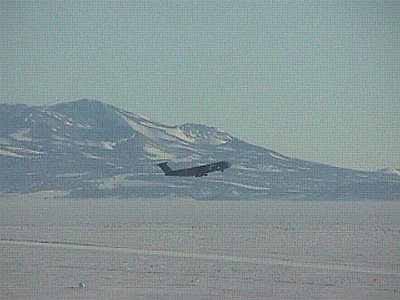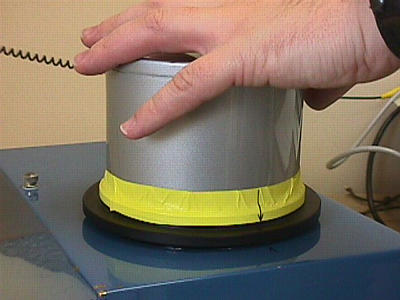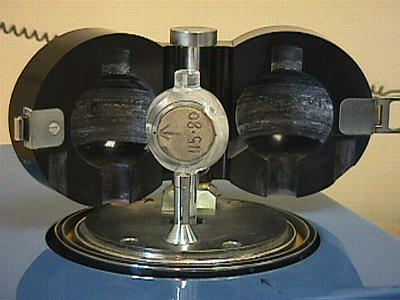9 November, 1998
Monday, November 9, 1998
Hi everyone! Things here are heating up…no, not the temperature, but the
activity in the Crary Lab associated with the Cape Roberts Project! We had
our usual 10 AM meeting today, and I learned some facts that I want to share
with you.
We had 6 new boxes of core to look at and sample today. The depth of these
cores was between 149.13 meters and 169.04 meters. The drill is now down to
over 200 meters. Some of the words that the sedimentologists used to describe
today's core were ones that I am gradually becoming more familiar
with…sandstone, siltstone, mudstone (predominately silt with some clay and
sand mixed in), carbonite cemetation, brecciation (broken up rock), shelly
bits, and fragments. There was some discussion about the rate of
sedimentation…how many centimeters of sediment accumulated in a certain amount
of time. The scientists are also interested in the coarseness of the
sediment, which in some cases is related to the depth of the water that the
sediment was deposited in. The teams working on nannofossils and microfossils
looks for evidence of diatoms, dinoflagelates, and other microscopic plants.
They also might see forams…micro-organisms.
Peter Webb and Ken Verosub both helped me understand a little about the "mud"
that the drillers have been waiting for. It was supposed to arrive on
yesterday's C-141 flight, but that plane didn't come down because of
mechanical problems. The "mud" is really a chemical (man-made) mud…made in a
factory using potassium chloride and a polymer gum. It is used at the drill
site. The mud is forced down the center of the drill hole where it is cutting
the rock. It keeps washing the rock away from the drill bit, to keep it from
jamming up. This liquid is a different weight (heavier) than the sediments
they're trying to push out. I will be able to tell you more after I get out
to the drill site. This trip should be coming up in the next couple of weeks.
Ken also taught me about "ice rafted debris"…the pebbles we see in the core.
These came from glaciers on shore. As the glaciers moved and picked up
pebbles, some of these eventually ended up stuck in icebergs that broke off
from the glacier and floated out to sea. These icebergs melted, and the rock
(pebbles) dropped down to the sea floor. The cores tell the story of geology
in and around Antarctica for millions of years!
New Topic! I also wanted to tell you about the C-5 Galaxy…Ken and Fabio did
some digging around and found some great web sites that can give you even more
info than what I'm about to tell you. Try them out and write to me to tell me
what you learned or what you liked! The first site is: www.lmasc.com and
you should go to the section that says "The Hangar" to learn more about the
planes made by Lockheed Martin. Another site: www.altavista.com and when
you get to the home page, type in C-5 Galaxy and then click on "search." Both
of these are cool sites!!
Here are MY favorite facts on the C-5 Galaxy:
** The cargo compartment of a C-5 can carry 100 Volkswagen Beetles or 6
Greyhound buses.
** The paint on the exterior (outside) of the C-5 weighs about 2,600 pounds!
** The distance the Wright Brothers flew was less than the length of the cargo
compartment of a C-5.
** Each wing of the C-5 weighs over 40,000 pounds!
** The C-5 contains over 103 miles of electrical wiring, 4 miles of hydraulic
tubing, and 5 miles of control cables.
** The C-5 carried enough fuel for the average American car to make 130 round
trips between New York and Los Angeles, or over 31 trips around the world!
** Cruise Speed: 540 miles per hour.
** Each plane costs about 184.2 million dollars.
** Primary function of the C-5 is massive strategic airlift.
** Range: Unlimited with in-flight refueling.
** Fuel capacity: 51,000 gallons
** Date first deployed: June 1970
** Total number in service: 126 aircraft
I couldn't believe all I learned by looking at the information from the web
sites…Hope you will take some time to do the same. I kept working in the lab
today using the Molspin demagnetizer, with Fabio on the spinner magnetometer.
We worked until 1:30 AM. We are working on shifts now, and Gary, Fabio and I
seem to be the night owls who like to stay up late and sleep in a bit. Talk
with you tomorrow.
Betty :)

This is a long shot of the C-5 Galaxy taking off from McMurdo today. Yes, we had another one fly in/out today. They are really trying to move the cargo between he re and Christchurch, New Zealand. We got to see it land and take off from the window in our lab. We have the best view of the ice runway.

Each time we work with one of the machines in our lab, we must put on a wrist band attached to a cord (looks a lot like a phone cord) . This prevents static elect ricity. Here I am..working with samples using the Molspin demagnetizer. I worked on samples and then handed them over to Fabio for measurements on the spinner magnetometer.

This is a close up shot of the lid on the spinner magnetometer.

Here's what the spinner looks like inside. See where the sample is placed...in the plastic holder in the middle. This gets closed up tight and then the other lid is put over top.
Contact the TEA in the field at
.
If you cannot connect through your browser, copy the
TEA's e-mail address in the "To:" line of
your favorite e-mail package.
|
